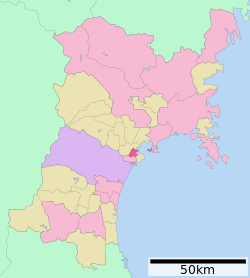Shiogama, Miyagi
|
Shiogama 塩竈市 |
|||
|---|---|---|---|
| City | |||

Urato islands
Shiogama Port, Shiogama Shrine Aeon Town Shiogama, Shiogama Port Festival |
|||
|
|||
 Location of Shiogama in Miyagi Prefecture |
|||
| Coordinates: 38°18′53″N 141°01′20″E / 38.31472°N 141.02222°ECoordinates: 38°18′53″N 141°01′20″E / 38.31472°N 141.02222°E | |||
| Country | Japan | ||
| Region | Tōhoku | ||
| Prefecture | Miyagi | ||
| Area | |||
| • Total | 17.86 km2 (6.90 sq mi) | ||
| Population (August 2014) | |||
| • Total | 54,621 | ||
| • Density | 3,060/km2 (7,900/sq mi) | ||
| Time zone | Japan Standard Time (UTC+9) | ||
| - Tree | Shiogama Sakura | ||
| - Flower | White Chrysanthemum | ||
| Phone number | 022-364-1111 | ||
| Address | 1-1 Asahimachi, Shiogama-shi, Miyagi-ken 985-8501 | ||
| Website | Official website | ||
Shiogama (塩竈市 and 塩釜市 Shiogama-shi?) is a city located in Miyagi Prefecture, Japan. As of August 2014, the city had an estimated population of 54,621 and a population density of 3060 persons per km². The total area was 17.86 km².
Shiogama is in north-central Miyagi Prefecture, bordered by the Pacific Ocean to the east.
"Shiogama" means "salt furnace" and refers to a local Shinto ritual involving the making of salt from sea water, still performed every July. The name is sometimes written using the kanji 塩釜 rather than 塩竈 and both spellings are officially permitted. Both 釜 and 竈 are pronounced gama in compounds, but as lone words they are pronounced kama and kamado, respectively. A (竈, "furnace") is a what a (釜, "kettle") is placed upon, and so the two are not completely interchangeable. 塩竈 is the form officially used by the city, but for ease of writing, the 10-stroke 釜 is often used in place of the 21-stroke 竈, such as in Shiogama Station.
Shiogama Jinja uses the rendering 鹽竈, with an archaic character for salt. This third form is rarely seen outside of this context.
The area of present-day Shiogama was part of ancient Mutsu Province, and has been settled since at least the Jomon period by the Emishi people. During the Nara period, the area came under the control of colonists from the Yamato dynasty based at nearby Tagajō and was the most important seaport in Mutsu. The ruins of the provincial capital of Mutsu Province have been found within the city borders. During later portion of the Heian period, the area was ruled by the Northern Fujiwara. During the Sengoku period, the area was contested by various samurai clans before the area came under the control of the Date clan of Sendai Domain during the Edo period, under the Tokugawa shogunate. The town of Shiogama was established with the creation of the municipalities system on April 1, 1889. Parts of Tagajō and Shichigahama were incorporated into Shiogama of September 1, 1938. Shiogama was raised to city status on November 23, 1941 (187th, nationally; 3rd in Miyagi). The city annexed the Gyūchi area of neighboring Tagajō on December 1, 1949 and the village of Urato on April 1, 1950.
...
Wikipedia



